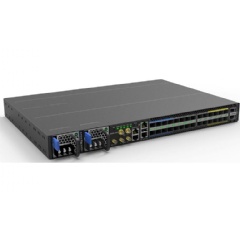AT&T Submits Specifications for White Box Cell Site Gateway Routers to Power 5G Era
Submission to Open Compute Project Allows Hardware Makers to Design Equipment AT&T Will Install in Over 60,000 Locations Over the Next Several Years
AT&T* is releasing this week to the Open Compute Project detailed specifications for a cell site gateway router, following up on an earlier commitment. This “white box” blueprint is a reference design that any hardware maker can use as a guide to build these routers. AT&T plans to install them at tens of thousands of cell towers over the next several years. These routers will eventually form the infrastructure that will enable not just phones and tablets to connect to our mobile 5G network, but new technologies like autonomous cars, drones, augmented reality and virtual reality systems, smart factories, and more
This white box approach to designing and building cell site gateway routers is part of our years-long transformation to create open platforms that speed innovation and spur competition among hardware makers. Rather than using proprietary solutions from a few vendors, we’re releasing these specs as open designs to all interested hardware manufacturers. If you’ve got the skills and an entrepreneurial spirit, we want to see what you can do.
“This transformation is about meeting the surging data demands of our customers as we head into this 5G world,” said Chris Rice, senior vice president, Network Cloud and Infrastructure at AT&T. “Data traffic on our wireless network has grown 360,000% since 2007. We now carry more than 222 petabytes of data on an average business day. The old hardware model simply can’t keep up, and we need to get faster and more efficient. We believe this white box approach helps us meet that demand while allowing us and others now to innovate faster than ever before.”
The cell site gateway router is a high-performance, versatile router. It’s designed to address the changing needs of the backhaul transport requirements as mobile service providers make the transition from legacy technologies toward 5G RAN technologies. It is an open hardware specification that can be coupled with a separate, disaggregated software solution. This creates several advantages:
- It decouples hardware from software, so providers have freedom to choose software implementations that best support their business and operational models.
- It is designed to support a wide range of speeds on the client side including 100M/1G needed for legacy Baseband Unit systems and next generation 5G Baseband Unit systems operating at 10G/25G and backhaul speeds up to 100G.
- It is designed to operate at industrial temperature ranges (-40C to +65C).
- It features the Broadcom Qumran-AX switching chip with deep buffers to support advanced features and QOS.
- It includes a baseboard management controller (BMC) for platform health status monitoring and recovery.
- It includes a powerful CPU for network operating software.
- It has timing circuitry that supports a variety of inputs and outputs to meet the evolving timing requirements and implementations in the 5G technology evolution.
“We’re very excited to be contributing our hardware specification to the Open Compute Project” said Michael Satterlee, vice president of Network Infrastructure and Services at AT&T Labs. “We’ve future-proofed it with high-speed interfaces and density, timing features, Quality of Service capabilities, and a powerful processor. We’re confident other mobile service providers will look at this spec and conclude, like us, that this platform can meet their needs.”
AT&T has been working with several original design manufacturers (ODMs) throughout the requirements development process. We expect several ODMs to submit detailed hardware designs that are compliant with the spec at the upcoming OCP meeting.
AT&T is developing its own network operating system software to control and manage the white box hardware.
“Our product development and quality assurance processes are structured to ensure we deliver a reliable, feature-rich, and secure product into our production network” said Ken Duell, assistant vice president of Packet Edge Development at AT&T Labs. “We take our time and do it right because we know the stakes are high. We’re on track to meet the commitment made earlier this year to begin First Field Applications (FFA) this calendar year and in time refreshing our entire base of over 60,000 cell site routers to this new white box implementation.”
The AT&T software solution is based on the technology acquired through the Vyatta acquisition in mid-2017.
“The Vyatta Network Operating System (NOS) stack is production-hardened and an excellent match for the demanding functional and reliability requirements of the cell site gateway router,” said Robert Bays, assistant vice president of Vyatta Development at AT&T Labs. “Consistent with our previous announcements to create the Disaggregated Network Operating System (DANOS) open source project, hosted by the Linux Foundation, we are now sorting out which components of the open cell site gateway router NOS we will be contributing to open source.”
( Press Release Image: https://photos.webwire.com/prmedia/6/229439/229439-1.jpg )
WebWireID229439
This news content was configured by WebWire editorial staff. Linking is permitted.
News Release Distribution and Press Release Distribution Services Provided by WebWire.
